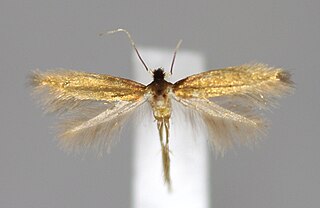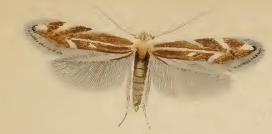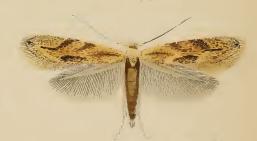
Bucculatrix canadensisella, the birch skeletonizer, is a moth of the family Bucculatricidae. The species was first described by Vactor Tousey Chambers in 1875. It is found in North America. In Canada, it has been recorded from New Brunswick to British Columbia, Nova Scotia and Prince Edward Island. In the United States, it has been recorded from New York, New Jersey, Michigan, Wisconsin, Minnesota, Pennsylvania, North Carolina, Tennessee, Kentucky and Colorado.

Bucculatrix frangutella is a moth of the family Bucculatricidae. It was described by Johann August Ephraim Goeze in 1783. It is found in Europe.

Bucculatrix cidarella is a moth of the family Bucculatricidae. It is found in most of Europe, Kazakhstan and Japan (Honshu). It was described in 1839 by Philipp Christoph Zeller.

Bucculatrix cristatella is a species of moth of the family Bucculatricidae. It is found in most of Europe. It was described in 1839 by Philipp Christoph Zeller.

Bucculatrix nigricomella is a species of moth of the family Bucculatricidae. It was first described in 1839 by Philipp Christoph Zeller. It is found in most of Europe.

Bucculatrix maritima is a species of moth of the family Bucculatricidae. It is found in most of Europe, Russia and Japan. It was first described in 1851 by Henry Tibbats Stainton.
Bucculatrix thurberiella, the cotton leaf perforator, is a species of moth of the family Bucculatricidae. It was first described by August Busck in 1914. It is native to the south-western United States and northern Mexico. It is an introduced species in Hawaii.

Bucculatrix ulmella is a moth of the family Bucculatricidae. It is found in most of Europe, except the Iberian Peninsula, Slovenia and Bulgaria. It was first described in 1848 by Philipp Christoph Zeller.

Bucculatrix bechsteinella is a moth of the family Bucculatricidae. It was described by Johann Matthäus Bechstein and Georg Ludwig Scharfenberg in 1805. It is found in most of Europe, except Greece and Bulgaria.

Bucculatrix demaryella is a moth of the family Bucculatricidae. The species was first described by Philogène Auguste Joseph Duponchel in 1840. It is found in most of Europe, Russia and Japan.
Bucculatrix quinquenotella is a species of moth of the family Bucculatricidae. It is found in North America, including Kentucky, Ohio, Michigan, Missouri, Iowa, Tennessee, Georgia, South Carolina, North Carolina, Washington D.C., New Jersey, Massachusetts, New Hampshire, Ontario, Quebec and Nova Scotia. It was described in 1875 by Vactor Tousey Chambers.
Bucculatrix agnella is a species of moth in the family Bucculatricidae. The species was first described by James Brackenridge Clemens in 1860. It is found in North America, where it has been recorded in Pennsylvania, New Jersey, New York, Washington D.C., Massachusetts, Indiana, Tennessee, Kentucky, Michigan, Missouri, South Dakota, Maine, Ohio and Texas.
Bucculatrix needhami is a moth in the family Bucculatricidae. It was first described in 1956 by Annette Frances Braun. It is found in North America, where it has been recorded from Florida, Kentucky, Illinois, Maine, New York, Ohio, South Carolina and Texas.
Bucculatrix inusitata is a moth in the family Bucculatricidae. It is found in North America, where it has been recorded from Quebec, Ontario, Indiana, Maine, Massachusetts, New York and New Jersey. It was described in 1963 by Annette Frances Braun.
Bucculatrix flourensiae is a species of moth in the family Bucculatricidae. It is found in North America, where it has been recorded from Arizona. It was described by Annette Frances Braun in 1963.
Bucculatrix speciosa is a moth in the family Bucculatricidae. It is found in North America, where it has been recorded from Indiana and West Virginia. It was first described in 1963 by Annette Frances Braun.
Bucculatrix improvisa is a moth in the family Bucculatricidae. It was described by Annette Frances Braun in 1963 and is found in North America, where it has been recorded from Ohio.
Bucculatrix luteella is a moth in the family Bucculatricidae. It was described in 1873 by Vactor Tousey Chambers. It is found in North America, where it has been recorded from Kentucky, Ohio, Iowa, Maine, New Jersey, Pennsylvania, Washington D.C., North Carolina and South Carolina.
Bucculatrix callistricha is a moth in the family Bucculatricidae. It is found in North America, where it has been recorded from Ohio, Kentucky, Maine, Wisconsin and Quebec. It was first described by Annette Frances Braun in 1963.
Bucculatrix caribbea is a moth species in the family Bucculatricidae and was first described in 2002 by Donald R. Davis and Bernard Landry. It is found on the island of Cozumel (Mexico) and Glovers Reef in Belize, but it is probably widespread along coastal areas in many parts of the Caribbean region.





